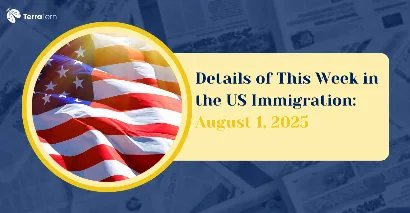Key Highlights
August 1, 2025, became an eventful week on the immigration scene in the U.S. with a number of major changes affecting nonimmigrant travel, exercise of employment visas, and family-based petitions. Whether it was far-reaching proposals on legislation in Congress or important policy developments by the Department of Homeland Security (DHS) and U.S. Citizenship and Immigration Services (USCIS), this was a period of change that will endure with the individuals, families, and businesses in the years to come. The general direction has been that of increased scrutiny and reformation as governmental agencies and legislators aim to clean up existing backlogs and to deal with national security issues, as well as discuss what the future of an immigration policy might hold.
Also Read: US Visitor Visa B1/B2
USCIS and DHS Introduce Noteworthy Policy Changes
August turned out to be a hot month as U.S. immigration agencies released a couple of important announcements, which explained and changed practices of both immigrants and nonimmigrants. These reforms can be seen to have two sides to them by keeping the integrity of the system intact and managing to streamline some of the processes on one hand, and a mixed tone on the other hand to the applicants.
Stricter Vetting for Family-Based Petitions
With a significant update on the policy front, the USCIS published new directions on how immigrant visa petitions are to be dealt with on a family level. The new update, which is effective immediately, increases the vetting and screening to prevent fraud and being sure of the family ties. The new guidance, included in the USCIS Policy Manual, specifically will set out to, in the USCIS estimation, as stated, detect and subvert fraudulent applications which they find to, in their estimation, undermine trust in the family-based immigration system.
The policy is the direct answer to the advocacy against marriage fraud and other fraudulent activities. USCIS has emphasized that the approval of a petition is not a guarantee to the beneficiary of exemption from removal procedures that can be meted out to her later in case of being declared ineligible or with a record of malicious intent. This implies that the applicants should expect even stricter interviews and more detailed evidence to submit to prove that a real relationship exists. The new provisions must be observed in pending and new petitions filed after August 1, 2025, and introduce yet another complexity and possible extension in processing periods among the thousands of applicants.
New B-1/B-2 Visa Bond Pilot Program
A one-year pilot programme of the requirement of a bond on the B-1/B-2 visitor visa was announced by the Department of State (DOS). Starting August 20, 2025, this program will pilot a bond system for a group of applicants whose country has a high rate of overstays. Consular officers will be given the allowance to impose bonds of 5,000, 10,000, and 15,000 dollars as a prerequisite to visa issuance. The aim is that visitors will go back to their home countries and not overstay their legal stay. Malawi and Zambia are the first countries on the list of those included in the program. This policy has sounded an alarm among the immigrant advocates on the monetary burden that this policy brings to the applicants and whether it can be a discriminatory policy. Moreover, the visas granted within the framework of this programme will be annotated, and the officers of Customs and Border Protection (CBP) are allowed to restrict the time of their stay to the shortest term, which is 30 days, another point of the lack of clarity that can cause inconveniences to travellers.
Also Read: Difference Between B1 and B2 Visa USA: Experts New Guide
Congressional Action and a Push for Reform
While the administrative agencies were busy with policy updates, Congress saw the introduction of new legislation aimed at tackling some of the most pressing issues in immigration today. A bipartisan bill, the Dignity Act of 2025, has emerged as a significant legislative effort to overhaul the current system and offer solutions for various immigration challenges.
The Dignity Act of 2025: A Bipartisan Proposal
Supported by Rep. Maria Elvira Salazar (R-Florida) and co-sponsored by Rep. Veronica Escobar (D-Texas), the Dignity Act of 2025 (H.R. 4393) aims to eliminate the backlogs on immigration visas and help the undocumented immigrants get legal status. This bill is a reformulation of a proposal that was once made and a fresh effort to identify a point of compromise on a very contentious issue.
The notable provisions of the legislation are that there is a plan to end the legal immigration backlog of visas within a 10-year period, and the proposed law is that anyone already waiting more than ten years can pay a premium processing fee of $20,000 to receive their visa. The provision will clear the backlog by 2035. The bill also introduces a raised per-country cap of employment-based and family-based green cards by setting the new limit of 15%, up by seven percentage points, which would largely alleviate the congestion problem observed in countries with heavy demand, such as India.
Another major element is the cover of the so-called Documented Dreamers, whose parents held work visas and who were brought to the U.S. long ago, but do not hesitate to lose their legal status once they reach age 21. The Dignity Act would help this population gain lawful permanent resident status, a major accomplishment for a group that is too infrequently considered in the immigration discussion. The bill would make other changes to employment and student-visa programs, such as making F-1 student visas dual-intent and establishing a presumption of eligibility for O visas in STEM and medical doctorates. The future of the bill is not clear yet, but given the bipartisan nature and a holistic approach to the problem, one might expect that the political decision-makers are serious about going beyond the political rhetoric to an effective immigration system.
Visa Bulletin Update: Mixed Signals for August 2025
The August 2025 Visa Bulletin issued by the U.S. Department of State has both good and bad news in different categories for applicants. The bulletin that determines the supply of immigration visas month to month gave one a bit of forward movement as well as a bit of retrogression in other respects.
Employment-Based Categories
On the positive side, there was great progress in the Final Action Date in the unreserved category of employment-based, the fifth preference (EB-5) in regard to India and China. The date of India changed to November 15, 2019, more than six months later, and the date of China to December 15, 2015. This comes as good news to the long-awaited applicants in these countries that have been affected by the high demand.
Nonetheless, this was not good news for other employment-based categories. All countries, except India and China, retrogressed in the employment-based (EB-2) category, which makes the Final Action Date retrograde to September 1, 2023. Such shifts are attributed to the demand for visas and the closing of the annual visa caps of the current fiscal year. Applicants using India as their country of origin had no movement in the EB-2 category since the last update in March 2012 and a small one-month forward to May 22, 2013, in the EB-3 category.
Also Read: Understanding B1 B2 Visa Rejection Reasons
Family-Sponsored Categories
The majority of the categories present in the family-sponsored visas did not have any changes compared to the last month, and this was an aspect of slow progress. The F2A subcategory of spouses and children of permanent residents, e.g., was unchanged at a Final Action Date of April 1, 2021, across all countries. The sluggish nature of such categories attests to the necessity of an overhaul that will solve the effect of the backlogs, such that the families remain separated by years. USCIS has stated that in August, it will remain in the family-sponsored adjustment of status category, using the Dates for Filing chart, to make some clarification available to those individuals who are anticipating going to the next stage of their application.








